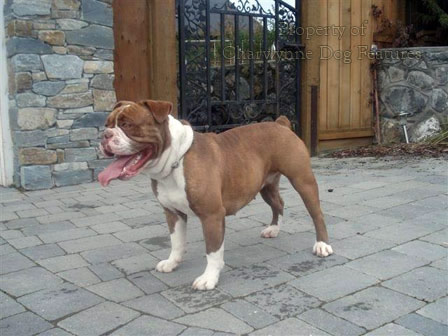291 Bulldog Show critique
BULLDOG CLASS CRITIQUE
by David Hancock
 DOG SPECTACULAR: 2 May 1999
DOG SPECTACULAR: 2 May 1999
General: An entry of a dozen American Bulldogs and one Victorian Bulldog produced a mixture of quality but a welcome consistency of active, lively, unexaggerated dogs and made an interesting contrast with a KC show ring for Bulldogs, where exaggeration amounting to deformity is the norm. The slippery surface made movement and the judging of it far from easy; the dogs were made to move slowly to give them the best chance of displaying soundness in these conditions. A larger outdoor ring would have permitted the extended trot which gives a judge a more valuable view of movement and so often reveals anatomical faults, especially a lack of coordination. Sound movement is much more vital in a large substantial dog, where excessive wear and tear on a heavy frame can be harmful to the dog. The pursuit of size for its own sake has ruined more than one KC- registered breed. For a 'catch-dog', agility, dash, power and sheer pound for pound physical strength will always be more important than height at the shoulder and great weight.
Forequarters: Heads were generally sound, with no massive skulls or dripping flews. A disproportionately large head is of no benefit to a Bulldog; too short a muzzle is a disaster. A breed expected to grip a dangerous adversary must be provided with a jaw that can seize and hold; this demands breadth and width. The KC-registered Bulldogs are practically muzzleless and could never emulate their ancestors in the baiting ring. The muzzle should be at least one third of the skull length if function is to be honoured. Eyes were good, with no small, sunken ones or slightly bulging ones, two faults which easily appear in the bull-breeds. Fronts were good, the skill is to obtain width without the dog being 'out at elbow', a dreadful fault in show Bulldogs one hundred years ago. Fore legs were good with no over-boning, an undesirable feature in so many mastiff-type dogs. We are breeding active agile animals here not cart-horses. Feet were disappointing, just not tight enough. Elbows were encouraging, close fitting but not restricting forward reach. Shoulders were well placed, allowing free movement. Necks could have been more powerful, this feature is vital for a holding dog. In dogs of this type, the weight is on the forehand with the centre of gravity well forward. This means that, on the move, the dog prefers to carry its head relatively low; handlers should not impose a high head carriage on such a dog when demonstrating movement.
Torsos: It was good to see no 'dippy' backs or croups higher than the shoulders. This latter fault is seen in both the Fila Brasileiro and the Neapoltan Mastiff, with some fanciers of the latter claiming it as a breed characteristic! When the dog is higher at the croup than the shoulders, it has to walk with an unnatural rolling gait, which places great stress on the hips, and 'crabbing' on the move because the hindlegs are longer than the front ones. This is far too tiring for a dog requiring to be active. A more or less level topline provides the strength of body essential in a holding breed. Ribs were well sprung and reached well back. Loins were strong. I look for a hand's width between the leading edge of the dog's thigh and the last rib. More than that and the dog can have a weak loin; less than that and the dog is too cobby and will often lack stamina. I also look for three fingers width between the shoulder blades, to allow free movement in the charge, without ranginess.
Hindquarters: Most dogs had commendably free movement behind but lacked a power-packed first and second thigh. There is a lack of thigh muscle in far too many American Bulldogs and it is a fault needing to be bred out. Holding dogs must have immense drive from their hindquarters; the weight is already well forward and balance can only be achieved if the dog has a really hefty backside.
Temperament: This was admirable; any dog of this size and build not displaying sound temperament will disgrace the breed one day. Dogs of this size and strength must not be allowed to jump up at people in greeting, it is dangerous (and painful!) It was disappointing to witness owners permitting their dogs to bark at will. Holding dogs giving tongue are a menace in the hunting field and a nuisance in society. Such dogs were once praised for their silence in combat (Japanese Tosas still are). A powerful brave willing dog yapping like a village cur is not a good advertisement for any catch-dog breed.
Final comment: It was a privilege to have the opportunity of going over these splendid dogs and to meet their owners. Keep the flag flying for real dogs!